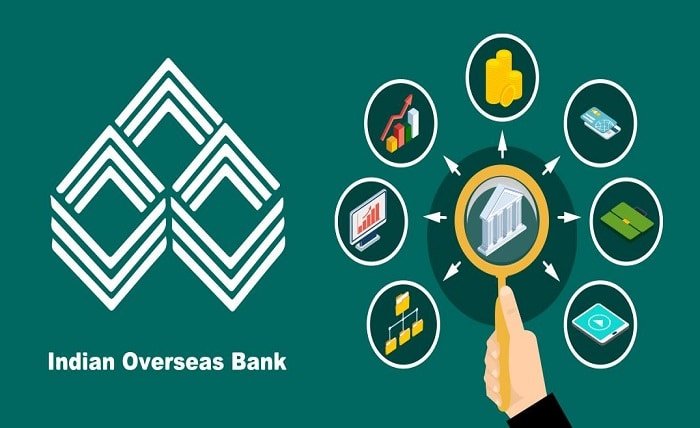NSE: IOB – Indian Overseas Bank’s Stock Performance on the National Stock Exchange

Introduction
Indian Overseas Bank (IOB) is one of India’s leading public sector banks, playing a crucial role in the Indian banking sector. With its stock listed on the National Stock Exchange (NSE) under the ticker symbol NSE: IOB, the bank is a key player in the stock market for investors interested in the banking industry. In this comprehensive blog post, we will delve into the various aspects of IOB’s stock, its performance, and what investors need to know when considering an investment in NSE: IOB.
We will analyze the historical trends, evaluate its current financial standing, explore challenges facing the bank, and offer insights into the bank’s potential growth in the coming years. By the end of this article, you’ll have a clearer understanding of whether NSE: IOB is the right investment choice for your portfolio.
History and Background of Indian Overseas Bank (IOB)
Indian Overseas Bank was founded in 1937 by M.Ct.M. Chidambaram Chettyar with the primary objective of specializing in foreign exchange business to encourage overseas banking in India. Over the decades, IOB has evolved into a full-fledged commercial bank offering a wide range of financial services.
IOB is headquartered in Chennai and operates with an extensive network of branches across India, as well as international branches in countries such as Singapore, Hong Kong, and Thailand. The bank is known for its strong foundation in foreign exchange and has been a pioneer in international banking services for Indian citizens and businesses.
Overview of NSE: IOB Stock
The NSE: IOB stock represents Indian Overseas Bank’s equity on the National Stock Exchange, one of the largest stock exchanges in India. The stock is categorized under the banking sector and forms part of various indices, including the Nifty PSU Bank index. As a public sector bank, IOB’s stock performance is influenced by government policies, macroeconomic factors, interest rate trends, and the overall performance of the Indian economy.
For potential investors, NSE: IOB provides an opportunity to invest in a public sector bank with a long-standing reputation. However, the stock also comes with inherent risks, particularly in terms of exposure to non-performing assets (NPAs) and the challenges faced by the Indian banking sector in general.
Historical Performance of NSE: IOB
Stock Price Trends
Historically, the NSE: IOB stock has seen fluctuations, reflecting the volatile nature of the banking industry in India. The stock has experienced significant highs and lows, driven by market sentiment, regulatory changes, and macroeconomic factors. For instance, the stock showed an upward trend during periods of economic growth and optimism in the banking sector but faced headwinds during times of financial crises and economic slowdowns.
Key Milestones
Several key milestones have shaped the performance of NSE: IOB over the years. These include periods of recapitalization by the Indian government, restructuring efforts to improve the bank’s financial health, and changes in leadership aimed at steering the bank toward profitability. Additionally, regulatory interventions, such as the Reserve Bank of India’s measures to improve asset quality and reduce NPAs, have impacted the stock’s trajectory.
Financial Analysis of Indian Overseas Bank
Revenue and Profitability
The financial performance of Indian Overseas Bank is a critical factor for investors analyzing the NSE: IOB stock. Over the years, IOB has worked to improve its revenue streams through diversified banking services, including retail banking, corporate banking, treasury operations, and international banking.
However, profitability has been a challenge for the bank, particularly in light of rising NPAs and provisions for bad loans. In recent financial reports, IOB has focused on strengthening its balance sheet and improving cost-efficiency to drive profitability in the coming years.
Asset Quality and NPAs
One of the major challenges facing Indian Overseas Bank has been its asset quality, specifically the high levels of non-performing assets. NPAs have remained a persistent issue for IOB, and the bank has undertaken several measures to reduce bad loans and improve asset recovery.
The performance of the NSE: IOB stock is closely linked to how effectively the bank can manage its NPAs. Investors should pay close attention to quarterly financial reports that highlight trends in asset quality, loan recovery rates, and provisions made by the bank.
Capital Adequacy and Recapitalization
As a public sector bank, Indian Overseas Bank has benefited from periodic capital infusion by the government of India. The capital adequacy ratio (CAR) is a key metric that investors should monitor to assess the bank’s ability to absorb potential losses and meet regulatory requirements. IOB has received recapitalization funds in the past, which have helped shore up its capital base and improve its financial health.
Factors Affecting NSE: IOB Stock Performance
Macroeconomic Environment
The broader macroeconomic environment plays a significant role in determining the performance of NSE: IOB. Economic growth, inflation, interest rates, and foreign exchange rates are some of the factors that influence the bank’s profitability and stock performance. During periods of robust economic growth, banks like IOB benefit from increased lending and higher credit demand, positively impacting their financials.
Conversely, during economic slowdowns or periods of high inflation, the banking sector often faces headwinds such as higher NPAs, reduced credit growth, and lower profitability.
Government Policies and Reforms
Being a public sector bank, Indian Overseas Bank is heavily influenced by government policies and reforms. Policies related to financial inclusion, agricultural loans, and infrastructure development directly affect the lending patterns of public sector banks like IOB. Moreover, regulatory changes and reforms aimed at improving the health of the banking sector can also have a significant impact on the stock’s performance.
For example, initiatives such as the Insolvency and Bankruptcy Code (IBC) have helped banks recover bad loans, which positively affects their balance sheets and stock prices. Government recapitalization efforts also play a crucial role in maintaining the financial stability of public sector banks.
Sectoral Trends in the Banking Industry
The performance of NSE: IOB is also influenced by trends within the banking industry. Key trends such as digital transformation, the rise of fintech, and the increasing use of technology in banking operations are shaping the future of the banking sector. Public sector banks like IOB are also adopting digital platforms to stay competitive, which could positively influence their stock performance.
Additionally, trends in credit growth, deposit rates, and loan interest rates are critical for understanding the banking sector’s health, which in turn affects IOB’s stock.
Challenges Facing Indian Overseas Bank
High Non-Performing Assets (NPAs)
As mentioned earlier, high NPAs have been a persistent challenge for Indian Overseas Bank. A large portion of the bank’s loan portfolio has turned into bad loans, affecting profitability and capital reserves. Although the bank has implemented recovery measures and participated in regulatory initiatives such as the Insolvency and Bankruptcy Code, the issue of NPAs remains a key concern for investors.
Competition from Private Sector Banks
The banking sector in India is highly competitive, with private sector banks like HDFC Bank, ICICI Bank, and Axis Bank dominating the market in terms of profitability and efficiency. Public sector banks like IOB often face challenges in competing with their private counterparts, which are known for their customer service, digital platforms, and innovation.
For IOB to remain competitive, it must invest in technology, improve operational efficiency, and offer better services to its customers. Failure to do so could result in losing market share to more agile private sector banks.
Capital Constraints
Public sector banks, including IOB, often face capital constraints that limit their ability to expand lending and improve profitability. While the Indian government has infused capital into IOB and other public sector banks, the capital requirements remain high, especially given the need for provisioning against bad loans and compliance with regulatory capital adequacy ratios.
Capital constraints also affect the bank’s ability to invest in technology, expand its branch network, and introduce new financial products, all of which are necessary to stay competitive in the banking industry.
Growth Opportunities for Indian Overseas Bank
Digital Transformation and Fintech Integration
One of the most significant opportunities for IOB lies in digital transformation. The banking sector is undergoing a massive shift towards digitalization, with customers increasingly opting for online banking, mobile applications, and fintech solutions. IOB has already made strides in this direction by offering digital banking services, but there is immense potential for further growth.
By partnering with fintech companies and investing in digital platforms, IOB can enhance its customer experience, improve operational efficiency, and tap into new revenue streams. This digital shift could positively impact the bank’s stock performance by attracting more customers and increasing profitability.
Expanding Retail and MSME Lending
Another growth opportunity for IOB is in expanding its retail and micro, small, and medium enterprises (MSME) lending. The Indian economy relies heavily on the MSME sector, which presents significant lending opportunities for banks. By focusing on retail and MSME lending, IOB can diversify its loan portfolio and reduce its reliance on corporate loans, which are more prone to turning into NPAs.
The Indian government’s push for financial inclusion and its focus on supporting MSMEs provide a conducive environment for public sector banks like IOB to expand their lending in these segments.
Strengthening International Operations
With branches in several international locations, IOB has the potential to strengthen its international operations and tap into global markets. Expanding its presence in foreign markets, particularly in regions with a large Indian diaspora, can provide IOB with new revenue streams and enhance its profitability.
Moreover, IOB’s expertise in foreign exchange services gives it a competitive edge in international banking, allowing the bank to cater to businesses engaged in cross-border trade.
Investor Sentiment and Market Perception of NSE: IOB
Public Sector Bank Perception
The perception of public sector banks among investors is often mixed. While some investors view public sector banks like IOB as stable due to government backing, others are concerned about the inefficiencies, high NPAs, and slower decision-making processes that are often associated with public sector banks.
For NSE: IOB to attract more investors, the bank must work on improving its financial health, reducing NPAs, and implementing reforms to enhance operational efficiency.
Analyst Recommendations
Financial analysts and brokerage firms often provide recommendations for stocks listed on the NSE, including NSE: IOB. These recommendations are based on a detailed analysis of the bank’s financial performance, market conditions, and future growth prospects.
Investors should consider these recommendations along with their own research before making an investment decision. Positive analyst recommendations can boost investor confidence and lead to an increase in stock prices, while negative recommendations can have the opposite effect.
Market Volatility and Stock Performance
Like all stocks, NSE: IOB is subject to market volatility. Factors such as economic uncertainty, regulatory changes, and global market conditions can lead to fluctuations in the stock price. Investors should be prepared for this volatility and have a long-term perspective when investing in banking stocks, particularly public sector banks like IOB.
Future Outlook for NSE: IOB
Recapitalization and Government Support
The Indian government has committed to supporting public sector banks through recapitalization initiatives. This support is crucial for IOB, as it provides the bank with the capital necessary to improve its financial health, reduce NPAs, and expand lending.
Government-backed recapitalization efforts are expected to continue in the coming years, which could provide a boost to IOB’s stock performance.
Economic Recovery and Growth Prospects
India’s economic recovery following the COVID-19 pandemic presents a positive outlook for the banking sector. As the economy rebounds and credit demand increases, IOB is well-positioned to benefit from the growing demand for loans, particularly in the retail and MSME segments.
Additionally, reforms aimed at improving the efficiency and profitability of public sector banks could have a positive impact on IOB’s future growth prospects.
Conclusion
NSE: IOB represents an interesting investment opportunity for those looking to invest in the Indian banking sector, particularly in public sector banks. While Indian Overseas Bank has faced challenges in terms of high NPAs, competition from private banks, and capital constraints, it also has significant growth potential.
By embracing digital transformation, expanding retail and MSME lending, and strengthening its international operations, IOB can position itself for future growth. Investors should closely monitor the bank’s financial performance, government support, and market conditions before making an investment decision.
FAQs
1. What is NSE: IOB?
NSE: IOB refers to the stock of Indian Overseas Bank listed on the National Stock Exchange of India.
2. Is NSE: IOB a good investment?
NSE: IOB can be a good investment for those looking to invest in public sector banks, but it comes with risks related to high NPAs and market volatility.
3. How has NSE: IOB performed historically?
The performance of NSE: IOB has seen fluctuations over the years, driven by economic conditions, government policies, and the bank’s financial performance.
4. What are the key challenges facing Indian Overseas Bank?
Key challenges include high non-performing assets (NPAs), competition from private sector banks, and capital constraints.
5. What growth opportunities exist for Indian Overseas Bank?
Growth opportunities include digital transformation, expanding retail and MSME lending, and strengthening international operations.




